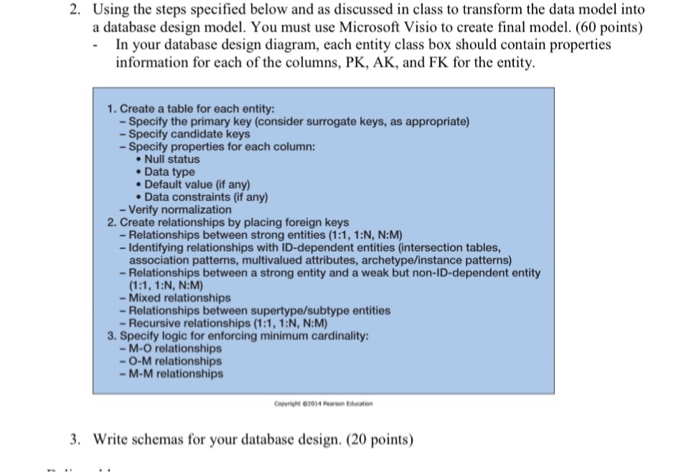Please, make a (database design model) for tutoring management system diagram. Follow the requirements shown in the picture

2. Using the steps specified below and as discussed in class to transform the data model into a database design model. You must use Microsoft Visio to create final model. (60 points) In your database design diagram, each entity class box should contain properties information for each of the columns, PK, AK, and FK for the entity 1. Create a table for each entity: -Specify the primary key (consider surrogate keys, as appropriate) Specify candidate keys -Specify properties for each column: Null status . Data type Default value (if any) Data constraints (if any) 2. Create relationships by placing foreign keys - Relationships between strong entities (1:1, 1:N, N:M) -Identifying relationships with ID-dependent entities (intersection tables, association patterns, multivalued attributes, archetype/instance patterns) -Relationships between a strong entity and a weak but non-ID-dependent entity - Mixed relationships -Relationships between supertype/subtype entities - Recursive relationships (1:1, 1:N, N:M) 3. Specify logic for enforcing minimum cardinality: - M-O relationships - O-M relationships - M-M relationships 3. Write schemas for your database design. (20 points) 2. Using the steps specified below and as discussed in class to transform the data model into a database design model. You must use Microsoft Visio to create final model. (60 points) In your database design diagram, each entity class box should contain properties information for each of the columns, PK, AK, and FK for the entity 1. Create a table for each entity: -Specify the primary key (consider surrogate keys, as appropriate) Specify candidate keys -Specify properties for each column: Null status . Data type Default value (if any) Data constraints (if any) 2. Create relationships by placing foreign keys - Relationships between strong entities (1:1, 1:N, N:M) -Identifying relationships with ID-dependent entities (intersection tables, association patterns, multivalued attributes, archetype/instance patterns) -Relationships between a strong entity and a weak but non-ID-dependent entity - Mixed relationships -Relationships between supertype/subtype entities - Recursive relationships (1:1, 1:N, N:M) 3. Specify logic for enforcing minimum cardinality: - M-O relationships - O-M relationships - M-M relationships 3. Write schemas for your database design. (20 points)








